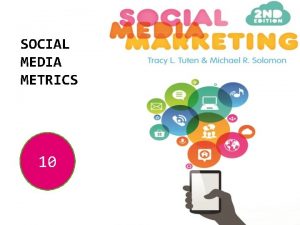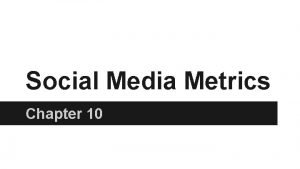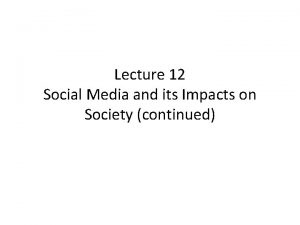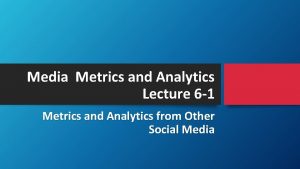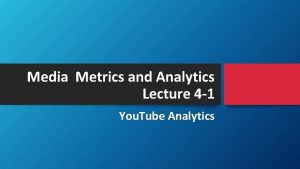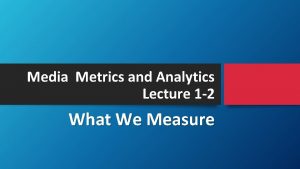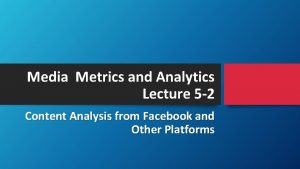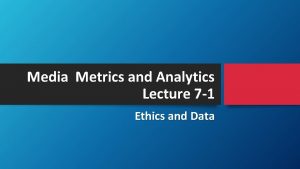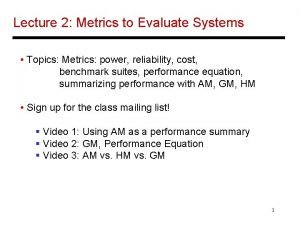Media Metrics and Analytics Lecture 2 2 Legacy



















- Slides: 19

Media Metrics and Analytics Lecture 2 -2 Legacy Metrics and Analytics

“Legacy” Media is Not Dead • Newspapers, magazines, radio, and television have seen erosion of their markets, but still are an important factor in media • Television, and television news, are actually pretty healthy • And print is still an important agenda-setter, even if readership has declined

Other Reasons Why Legacy Media are Important • Also, understanding legacy media gives insight into the history of our quest to measure • Metrics were – and still are, to an extent – broad estimates but were the best we had • Like umpires calling balls and strikes, we knew that there was inherent error but lived with it

Problems with Legacy Media Measurement Among the errors… • Inexact measurement methods, such as having people fill out diaries – even if they were not fluent in the language • Uncertainty as to what the figures meant – say, if someone were watching television, we didn’t know how closely

However, the Measures were the Best We Had • Sort of a mutual agreement that everyone played by the same rules, even if the method of enforcing the rules was flawed • But as we’ll see, even though online measurement can be much more specific, we’re still not sure if what we are measuring reflects value • Example: Do we count raw pageviews or some other form of engagement

Newspaper Circulation • Circulation was coin of the realm • Fueled subscription sales, and subscription sales are coveted because all money is paid in advance – publisher gets, for example, a year’s worth of income before producing the product

Problems in Measuring Newspaper Circulation • Circulation is not the same thing as readership • Readership = people who read the publication, including the same issue of the publication • Readership includes “pass along” – which must be inferred from surveys • Surveys can involve guesswork

Other Problems in Newspaper Circulation • Hard to tell how many were actually sold by wholesalers • Unsold copies might not be counted or returned at a later date • Hard to determine how closely someone read publication…again, involves surveys, interviews, and some guesswork • Newspapers have even tried “eye tracking”

Magazine Circulation Measurement • Magazines have different methods of distribution that newspapers • Free or controlled circulation more common in magazine world than in newspapers • Magazines tend to have more “durability” – TV Guide was an example • Some durable magazines can have 15 or more readers

Problems in Measuring Magazine Circulation and Readership • Hard to count durability, magazines’ biggest strength • Also, if given away free or even sold, still complicated to ensure what is actually sold (as well as what is actually read) • Hard to get an accurate sample with a small sample size • Audit Bureau of Circulation

Radio and Television Ratings • Broadcast and cable ratings broken down by daypart and sometimes into very specific demographics • Demographics are particularly important to radio because radio often sells to a highly segmented audience • Desirable (all-news) vs. less profitable (albumoriented rock) demos

Radio and Television Demographics Measure Many Different Things • Demographics – sex, age, etc. • Time of day – vitally important to radio • Listeners and viewers for specific programs and program segments • Tune-out

Examples of How Ratings Work • Remember, “ratings” is a broad category in its informal meaning AND a specific term • Rating, in precise meaning, is portion of total viewing or listening audience (“universe”) • Ratings often applied to specific demographic • Share is percentage of listeners or views actually tuned in…a radio share of 7 means 7 percent of all listeners actually using a radio were listening to the particular station

More on Ratings… • AQH – average quarter hour persons – a complicated measure that basically means how many people tuned in for at least five minutes during each 15 -minute segment • AQH is basically a measure trying to quantify a meaningful amount of listenership

More on Ratings… • Cume – Cumulative audience, meaning unduplicated audience over a specified period of time • Turnover – In broad terms, how many listeners are replaced by new listeners, derived from a calculation involving AQH and cume.

Problems with Ratings… • It’s hard to be precise because we don’t know the level of engagement a listener or viewer has • While television ratings companies have tried to come up with ways to monitor viewers without being too intrusive, it’s hard to tell how many are watching a set and how closely they are paying attention • Demographic information can be vague because it is often self-reported or based on small surveys

A Few Other Concepts • Gross impressions – How many times a commercial is heard by a person (any person, even the same person) • Reach – How many different listeners hear a message • Frequency – Number of times a theoretical listener hears a particular commercial

Have You Noticed a Few Common Concepts? • Ratings and circulation figures try, given their limitations, to come up with meaningful numbers • We want to know who we are reaching and how often • We want to be able to separate unique people from returning people in our samples • We also want to know if the people we are reaching stay with us • We are limited by fundamental measurement problems

What’s Ahead • We’ll see how those common concepts have evolved along with the media • Specifically, we’ll examine how digital technology can measure and report with astonishing precision • And the examination begins with the what is probably the most important media company in history -- Google
 Stephan sorger
Stephan sorger Hr metrics and workforce analytics
Hr metrics and workforce analytics Teramond
Teramond 01:640:244 lecture notes - lecture 15: plat, idah, farad
01:640:244 lecture notes - lecture 15: plat, idah, farad Social media objectives and metrics
Social media objectives and metrics Social media marketing metrics matrix
Social media marketing metrics matrix Big data and social media analytics
Big data and social media analytics Catbeller
Catbeller Watson analytics for social media
Watson analytics for social media Social media analytics tutorial
Social media analytics tutorial Lecture about social media
Lecture about social media Chapter 22 section 5 the end of the war and its legacy
Chapter 22 section 5 the end of the war and its legacy Napster and its legacy in distributed system
Napster and its legacy in distributed system What can we learn from studying ancient greek artwork
What can we learn from studying ancient greek artwork Chapter 17 manifest destiny and its legacy
Chapter 17 manifest destiny and its legacy The life and legacy of andrew jackson doodle notes
The life and legacy of andrew jackson doodle notes The legacy of ancient greece and rome
The legacy of ancient greece and rome Zapotec influence and legacy
Zapotec influence and legacy Type of people media
Type of people media Robert frost legacy
Robert frost legacy




